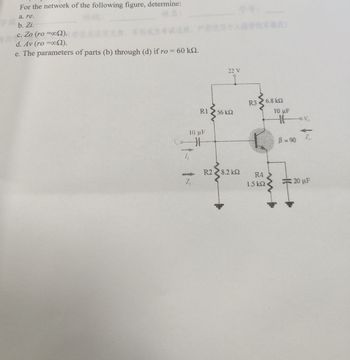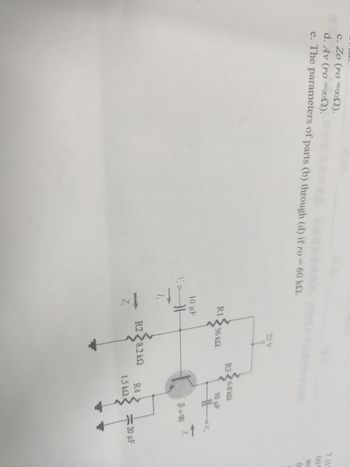
Introductory Circuit Analysis (13th Edition)
13th Edition
ISBN: 9780133923605
Author: Robert L. Boylestad
Publisher: PEARSON
expand_more
expand_more
format_list_bulleted
Question
thumb_up100%

Transcribed Image Text:#1
**
For the network of the following figure, determine:
a. re.
b. Zi.
c. Zo (ro).
d. Av (ro =∞o).
e. The parameters of parts (b) through (d) if ro = 60 km2.
2
Z₁
RI
10 µF
St
22 V
56 kQ
R2 8.2kQ
R3
R4
1.5 kQ
6.8 kQ
10 µF
Htv₂
B =90
Z
20 µF
Expert Solution
This question has been solved!
Explore an expertly crafted, step-by-step solution for a thorough understanding of key concepts.
Step by stepSolved in 3 steps with 1 images

Follow-up Questions
Read through expert solutions to related follow-up questions below.
Follow-up Question
Thanks and please do the these. Thanks

Transcribed Image Text:c. Zo (ro =∞oN).
d. Av (ro=005).
e. The parameters of parts (b) through (d) if ro = 60 kn.
ΚΩ.
R1256 kQ
10 uF
10-1
I
HH
22 V
Z₁
R326.8kQ
R228.2 k2
10 µF
R4
1.5kQ
V₂
8=90 Z
20 uF
7.(15
and
(6
Solution
by Bartleby Expert
Follow-up Questions
Read through expert solutions to related follow-up questions below.
Follow-up Question
Thanks and please do the these. Thanks

Transcribed Image Text:c. Zo (ro =∞oN).
d. Av (ro=005).
e. The parameters of parts (b) through (d) if ro = 60 kn.
ΚΩ.
R1256 kQ
10 uF
10-1
I
HH
22 V
Z₁
R326.8kQ
R228.2 k2
10 µF
R4
1.5kQ
V₂
8=90 Z
20 uF
7.(15
and
(6
Solution
by Bartleby Expert
Knowledge Booster
Learn more about
Need a deep-dive on the concept behind this application? Look no further. Learn more about this topic, electrical-engineering and related others by exploring similar questions and additional content below.Similar questions
- For the following circuit, Vsrc=1.5 V and Rload%3D225 Q. What is Is? Is +. Vsrc VR Rload 30 mA 9 mA 6.67 mA 40 mVarrow_forwardJust b)arrow_forwardO b. None of them C. Req=36.67 Q,P=-3.92W. O d. Req=61.5 Q,P=-2.34W. e. Req=36 0,P=-4W. estion 4 For this circuit, the values of 11, 12 and V are: yet swered 11 12 arked out of R1 R2 R3 R4 Is 15 A V 50 10 Q 10 Q Flag uestion Select one: O a. 11= 10J12 = 5 A, V=50 V O b. 11 = 5 A, 12 = 2.5 A, V=25 V O c. 11 = 5 A, 12 = 2.5, V=50 V O d. 11 = 2.5 A, 12 = 5 A, V=25 V Question 5 Find Rab- Not yet arswered 20 Q AAAA Marked our of TOSHIBAarrow_forward
- 6. The main difference between resistance R and capacitive reactance X, is that (a) Xc is the same for both DC and AC signals, where R depends on frequency of the AC signal (b) R is the same for both DC and AC signals, where X depends on the frequency of an AC signal (c) R is measured in ohms and X is measured in farads (d) None of the abovearrow_forwardA resistor R and a capacitor C are connected in series across a 400 V variable ac supply. When the frequency is 40 Hz, it draws 10 A current, and when the frequency is 50 Hz, it draws 15 A current. Find R and C.arrow_forward
arrow_back_ios
arrow_forward_ios
Recommended textbooks for you
 Introductory Circuit Analysis (13th Edition)Electrical EngineeringISBN:9780133923605Author:Robert L. BoylestadPublisher:PEARSON
Introductory Circuit Analysis (13th Edition)Electrical EngineeringISBN:9780133923605Author:Robert L. BoylestadPublisher:PEARSON Delmar's Standard Textbook Of ElectricityElectrical EngineeringISBN:9781337900348Author:Stephen L. HermanPublisher:Cengage Learning
Delmar's Standard Textbook Of ElectricityElectrical EngineeringISBN:9781337900348Author:Stephen L. HermanPublisher:Cengage Learning Programmable Logic ControllersElectrical EngineeringISBN:9780073373843Author:Frank D. PetruzellaPublisher:McGraw-Hill Education
Programmable Logic ControllersElectrical EngineeringISBN:9780073373843Author:Frank D. PetruzellaPublisher:McGraw-Hill Education Fundamentals of Electric CircuitsElectrical EngineeringISBN:9780078028229Author:Charles K Alexander, Matthew SadikuPublisher:McGraw-Hill Education
Fundamentals of Electric CircuitsElectrical EngineeringISBN:9780078028229Author:Charles K Alexander, Matthew SadikuPublisher:McGraw-Hill Education Electric Circuits. (11th Edition)Electrical EngineeringISBN:9780134746968Author:James W. Nilsson, Susan RiedelPublisher:PEARSON
Electric Circuits. (11th Edition)Electrical EngineeringISBN:9780134746968Author:James W. Nilsson, Susan RiedelPublisher:PEARSON Engineering ElectromagneticsElectrical EngineeringISBN:9780078028151Author:Hayt, William H. (william Hart), Jr, BUCK, John A.Publisher:Mcgraw-hill Education,
Engineering ElectromagneticsElectrical EngineeringISBN:9780078028151Author:Hayt, William H. (william Hart), Jr, BUCK, John A.Publisher:Mcgraw-hill Education,

Introductory Circuit Analysis (13th Edition)
Electrical Engineering
ISBN:9780133923605
Author:Robert L. Boylestad
Publisher:PEARSON

Delmar's Standard Textbook Of Electricity
Electrical Engineering
ISBN:9781337900348
Author:Stephen L. Herman
Publisher:Cengage Learning

Programmable Logic Controllers
Electrical Engineering
ISBN:9780073373843
Author:Frank D. Petruzella
Publisher:McGraw-Hill Education

Fundamentals of Electric Circuits
Electrical Engineering
ISBN:9780078028229
Author:Charles K Alexander, Matthew Sadiku
Publisher:McGraw-Hill Education

Electric Circuits. (11th Edition)
Electrical Engineering
ISBN:9780134746968
Author:James W. Nilsson, Susan Riedel
Publisher:PEARSON

Engineering Electromagnetics
Electrical Engineering
ISBN:9780078028151
Author:Hayt, William H. (william Hart), Jr, BUCK, John A.
Publisher:Mcgraw-hill Education,